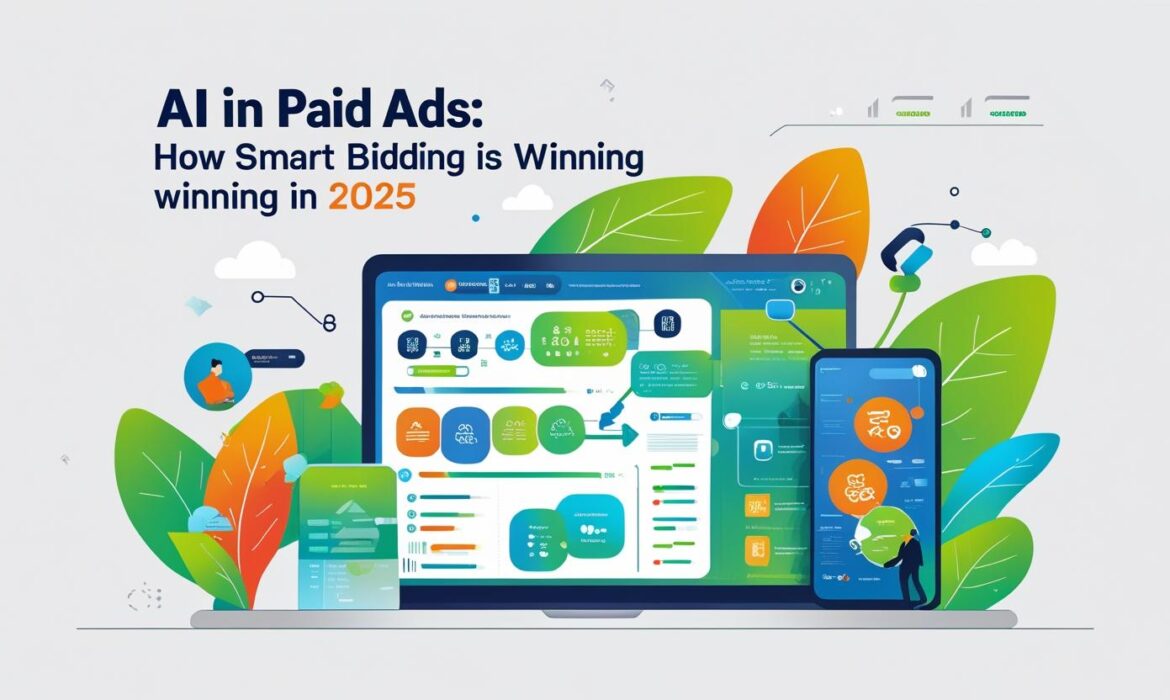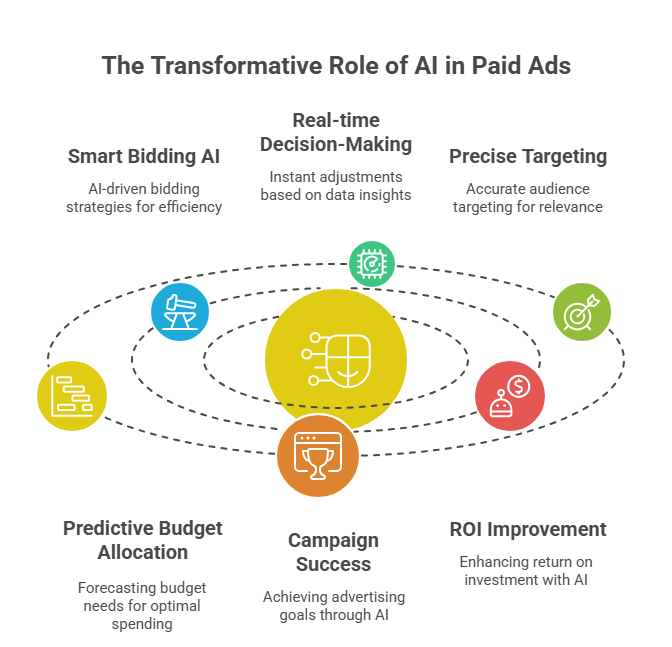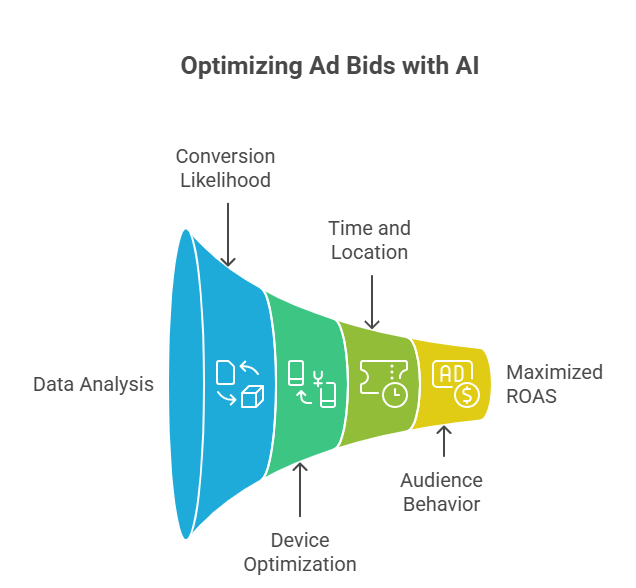
In the rapidly evolving world of digital marketing, paid advertising has become smarter, faster, and more efficient—thanks to the integration of artificial intelligence. In 2025, AI in Paid Ads 2025 is not just a buzzword but a transformative tool driving campaign success and ROI. Whether you’re managing Google Ads, running programmatic campaigns, or optimizing for social platforms, understanding Smart Bidding AI is no longer optional—it’s essential.
Modern marketers are embracing AI in Paid Ads because it enables real-time decision-making, precise targeting, and predictive budget allocation. According to eMarketer, 86% of digital advertisers plan to rely on AI PPC strategy to outperform competition. As we move deeper into the AI era, let’s explore how the Future of Paid Ads AI is reshaping the advertising landscape.

What Is Smart Bidding AI?
Smart Bidding AI is an automated bid strategy powered by machine learning. It adjusts bids based on conversion likelihood, device, time, location, audience behavior, and other signals. With AI in Paid Ads 2025, bidding is no longer about guesswork—it’s about intelligent optimization.
Tools like Google Ads Smart Bidding and Performance Max Campaigns analyze vast datasets in real-time, making thousands of bid adjustments daily to maximize conversions and Return on Ad Spend (ROAS) AI.

Why AI for Paid Advertising Works in 2025
The reason AI in Paid Ads is dominating in 2025 is simple: it works. Here’s why:
- Real-time Bidding: Instantly adjust bids to match user context
- Automated Bid Strategies: Reduce manual input, improve efficiency
- Audience Targeting AI: Identify high-converting audience segments using behavioral data
- Dynamic Creative Optimization: Test and serve the best-performing ad variations automatically
- Campaign Optimization with AI: Continuously refine targeting, bidding, and messaging based on live performance
According to Statista, AI-optimized campaigns have seen a 33% better conversion rate compared to manually optimized ones.
Top Platforms Using AI in Paid Ads
Several platforms have fully integrated AI PPC strategy features:
- Google Ads: With Performance Max Campaigns, it automates bidding, creatives, and placements.
- Facebook Ads: Utilizes AI for paid advertising to predict audience behavior and placement efficiency.
- LinkedIn Ads: Uses machine learning bidding to improve ad delivery and engagement.
- Amazon Ads: Optimizes placements using buyer intent signals.
- DSPs for Programmatic Advertising AI: Platforms like The Trade Desk automate inventory and bids with predictive models.
Programmatic Advertising AI: The Bigger Picture
Programmatic Advertising AI is the backbone of real-time media buying. Instead of human negotiations, AI handles the inventory selection, bid placement, and audience matching. In 2025, over 92% of display ads are expected to be transacted programmatically.
With AI in Paid Ads 2025, brands can:
- Reduce waste by avoiding low-performing impressions
- Use Real-time Bidding for dynamic auctions
- Leverage Ad Personalization AI for better user engagement
Programmatic buying platforms also use PPC automation to scale campaigns across channels without sacrificing control. Marketers get end-to-end visibility and can allocate budgets dynamically based on performance insights.
Smart Bidding + Ad Personalization = Performance
Combining Smart Bidding AI with Ad Personalization AI creates powerful results:
- Customized ads based on demographics, browsing behavior, and psychographics
- Real-time adjustments based on CTR, bounce rate, and engagement levels
- Higher relevance leads to better Quality Score and reduced CPC
Tools like Meta Advantage+ and Google’s AI-driven ad variations prove this approach increases ROAS AI by up to 40%.
Optimizing Campaigns with AI in 2025
Effective campaign optimization with AI involves:
- Monitoring audience performance in real-time
- Letting AI PPC strategy decide bid adjustments
- Automatically pausing underperforming ads
- Predicting the best time of day or device for ad delivery
- Using Dynamic Creative Optimization to test messaging variations
Marketers now rely on AI in Paid Ads to personalize experiences and make smarter investments. Brands using AI see better user retention and faster conversions due to consistent performance tuning.
Challenges and Solutions
While AI in Paid Ads 2025 offers undeniable benefits, challenges remain:
- Loss of Control: Relying on machines may feel risky, but transparency tools now show decision logic.
- Learning Periods: AI needs data to learn. Running longer campaigns helps.
- Privacy Compliance: AI must be compliant with regulations like GDPR while collecting behavioral data.
- Over-Reliance on Algorithms: Human oversight ensures campaigns stay aligned with brand goals.
Despite the challenges, the pros far outweigh the cons when implemented strategically.
Future of Paid Ads AI: What’s Next?
In the Future of Paid Ads AI, expect deeper integrations:
- Voice & Visual Search Optimization
- AI-generated ad creatives
- AI-driven CRO landing pages
- PPC Automation across omnichannel ecosystems
- Predictive budget optimization based on real-time trends
Soon, we’ll see full-funnel automation—from creative to conversion—fueled by AI in Paid Ads 2025. With Automated Bid Strategies and AI PPC strategy, even small businesses can compete on a global scale.
Conclusion: Embrace the Evolution
Whether you’re running search, display, social, or programmatic, AI in Paid Ads is the competitive edge in 2025. With tools like Smart Bidding AI, Dynamic Creative Optimization, and campaign optimization with AI, marketers are seeing better targeting, improved efficiency, and increased ROI.
The future is not manual—it’s intelligent. Embrace AI PPC strategy now and let automation guide your growth in the fast-paced world of paid ads. With Programmatic Advertising AI and Ad Personalization AI, your brand can deliver smarter, faster, and more personalized experiences that drive results.




